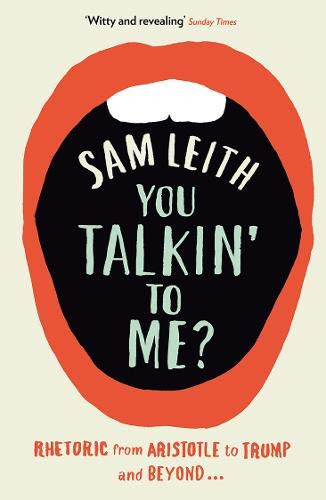You Talkin' To Me: Rhetoric from Aristotle to Trump and Beyond is a lighthearted introduction to the field of rhetorics.
The author makes the case that rhetorics, frequently perceived as obscure and theoretical, is, in reality, a field of study full of practicality, quirk, and joyfulness.
He succeeds.
Satan's Ethos
The book is largely a collection of snippets from speeches and works of literature introducing the basic systems of rhetorics and their mechanics in detail. The author dedicates the bulk of the book to discussing the five essential parts of rhetorics:
- Invention devises your line of argument. Ethos, logos, and pathos are the chief ways to relate to the audience, convince it with reason, and stir them with emotion.
- Arrangement finds the optimal ordering of your ethos, logos, and pathos for maximum impact.
- Style bundles of decisions you will make about which rhetoric flairs you'll use to entertain, energize, and enrage.
- Memory helps you remember what you want to say without sounding like a robot.
- Delivery selects the right tone of voice, employs folksiness, and makes you sound like the hero your audience demands you to be.
Intermingled with the chapters on individual rhetoric skills are sections dedicated to some of the great orators, from Aristotle to Abe Lincoln. This selection's diversity provides a great perspective on the universal value of mastering rhetorics, from obvious choices (Cicero, Barrack Obama), through professional speechwriters, ending with a few anti-heroes (Richard Nixon and Satan).
Reading Nixon's and Satan's arguments for why they are not all bad is pure joy. The dissection of these speeches alone makes the book worth reading.
Return of the Playful
Aside from a great run-through of the history and systemization of rhetorics, the book is a joy to read, thanks to its witty, playful, and uncompromising writing.
The author frequently switches from long sentences loaded with hard-to-understand archaisms to folksy punchlines, all while continuously delivering interesting insights about rhetorics and the people who practice it.
The author's self-proclaimed goal is to show readers how fun rhetorics can be.
The continuous march of alliteration, anaphora, and apostrophe in the author's writing drives this point home by delivering an entertaining but highly informative read.
So much so that after reading the book, it's hard to go back to the newly minted remote way of working full of written communication hyper-focused on clarity and optimized for skimming, devoid of any linguistic flourishes and playfulness.
Rhetorics can be for remote workers what mechanical keyboards are for the office-goers. Slightly unnecessary and noisy but also bringing unexpected joy to everyone who gives them a try.
In the same way that seeing the joy of a colleague who is smugly writing on a mechanical keyboard so loud they needed to buy noise-canceling headphones makes you smile just a bit, so will seeing your remote colleague work a sneaky tricolon into their weekly progress report bring a bit of unexpected joy into your day.
Maybe next time, you will alliterate your weekly report with the hope that it will bring a smile to that random person who read it and realized what you did.
Go read You Talkin' To Me: Rhetoric from Aristotle to Trump and Beyond. It's a ton of fun. Plus, you learn a lot about an art form you both encounter and perform many times a day without even realizing it!

Cover credit: Kristina Paparo on Unsplash